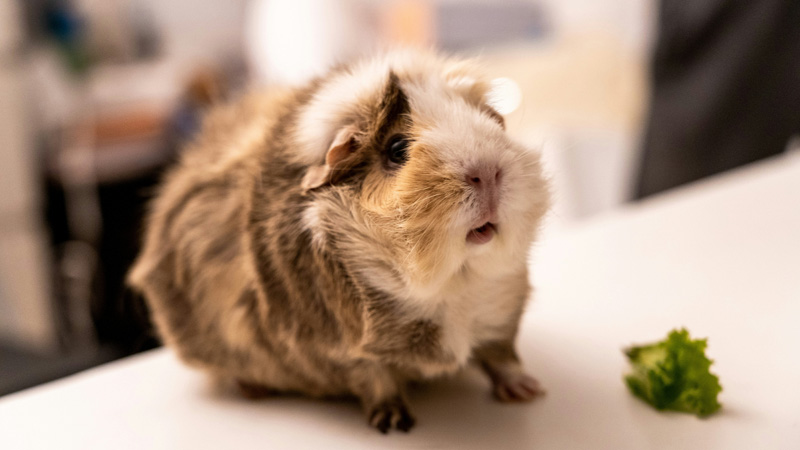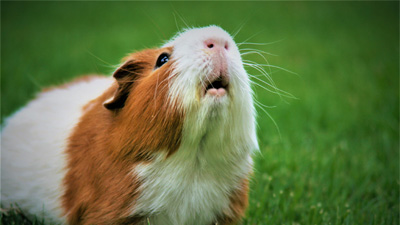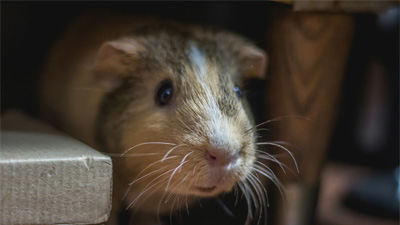Can Guinea Pigs Eat Celery? (Yes! Moderation)

Photo by Yuhan Du on Unsplash
Guinea pigs are adorable, social, and active animals that require a well-balanced and nutritious diet for optimal health. A healthy diet for guinea pigs includes hay, fresh fruits and vegetables, and fortified pellets. While guinea pigs can eat many types of fruits and vegetables, celery stands out as an excellent source of essential nutrients like vitamins C and K, fiber, and potassium.
In this comprehensive guide, we will explore the question “Can guinea pigs eat celery?” and examine its nutritional value, potential benefits, possible risks, and guidelines for feeding this vegetable to your furry friends.
Nutritional Value of Celery for Guinea Pigs
Celery is a crunchy and juicy vegetable that belongs to the parsley family and is an excellent source of nutrients such as:
Vitamin C: Guinea pigs are unable to produce vitamin C on their own; therefore, they need to obtain it through their diet. Celery is a great source of this essential nutrient that supports overall health, immune function, and wound healing.
Vitamin K: Celery leaves are especially rich in vitamin K, which plays a key role in blood clotting and maintaining bone health.
Fiber: Celery is also rich in fiber, which supports healthy digestion and can help prevent gastrointestinal issues in guinea pigs.
Water Content: Celery is also high in water content, which helps to keep guinea pigs hydrated. Keeping your furry companion hydrated is crucial for their overall health and well-being.
Potassium: Celery is a good source of potassium, an electrolyte mineral that is essential for maintaining healthy blood pressure and fluid balance in the body.
Benefits of Celery for Guinea Pigs
Incorporating a small portion of celery into your guinea pig’s diet can offer several health benefits, including:
Improved Digestion: Celery contains fiber that promotes healthy bowel movements and reduces the risk of constipation and gastrointestinal issues.
Strengthened Immune System: Celery is rich in vitamin C, which is essential for a strong and healthy immune system.
Healthy Skin and Coat: The vitamins and minerals present in celery can help support healthy skin and coat for guinea pigs.
Regulated Blood Pressure: The high potassium content in celery can help regulate blood pressure in guinea pigs, which is important for cardiovascular health.
Risks and Considerations of Feeding Celery to Guinea Pigs
While celery offers several potential health benefits for guinea pigs, it's important to consider the possible risks and downsides of feeding this vegetable to your furry friends.
High Oxalic Acid Content: Celery contains oxalic acid, a compound that can bind with calcium and result in bladder stone formation in guinea pigs. While the amount of oxalic acid in celery is relatively low, it's still important to offer it in small quantities.
Risk of Choking: Celery contains stringy fibers that can cause choking, especially if served in large pieces. Always ensure that celery is chopped into small pieces and the stringy fibers removed.
Digestive Upset: introducing a new food to your guinea pig's diet can cause digestive upset, including bloating, gas, and diarrhea. Introduce celery gradually and in small quantities to help avoid these issues.
Guidelines for Feeding Celery to Guinea Pigs
If you decide to offer celery to your guinea pig, it's essential to follow these guidelines:
Moderation: Celery should be offered in moderation as part of a balanced diet, including a variety of vegetables, fruits, and hay. A 1-inch piece of celery with the leaves attached is a sufficient serving size.
Freshness and Quality: Choose fresh and crisp celery with bright green leaves that show no signs of wilting or discoloration.
Preparation: Rinse celery thoroughly and chop it into small pieces to avoid choking hazards. Remove any stringy fibers from the celery as well.
Variety: Variety is essential to provide a balanced diet, so it's important to mix celery with other fresh vegetables like bell peppers, carrots, and lettuce.
Observation: Observe your guinea pig closely after giving them celery for any signs of digestive upset or adverse reactions. If any issues arise, discontinue feeding celery, and consult a veterinarian if necessary.
Conclusion
While celery can be a nutritious addition to your guinea pig's diet, it's important to offer it in moderation. As with most vegetables, guinea pigs can safely consume a small amount of celery as part of a well-balanced diet that includes a variety of other fresh fruits and vegetables.
It's recommended to offer your guinea pig no more than a 2-inch section of celery with some of the leaves included, up to three times per week. This will provide your guinea pig with the necessary nutrients without overloading them with excessive fiber.
When feeding celery to your guinea pig, it's best to mix it in with plenty of leafy vegetables such as lettuce, cabbage, or kale. Adding a tiny portion of fruits like berries or apples can also add variety to their diet. However, avoid giving your guinea pig a whole celery stick as it is too much, and about a sixth of a stalk per piggy is sufficient.
As with any new food, it's important to introduce celery gradually and monitor your guinea pig's reaction for any signs of digestive upset or adverse reactions. If you notice any issues, discontinue offering celery and consult with a veterinarian if necessary.
You May Also Like
 Guinea PigWhat Do Guinea Pig Noises Mean?
Guinea PigWhat Do Guinea Pig Noises Mean? Guinea PigGuinea Pigs vs. Hamsters: What Is the Difference?
Guinea PigGuinea Pigs vs. Hamsters: What Is the Difference? Guinea PigMale vs. Female Guinea Pig: What Is the Difference?
Guinea PigMale vs. Female Guinea Pig: What Is the Difference? Guinea PigCan Guinea Pigs Have Mango? Yes!
Guinea PigCan Guinea Pigs Have Mango? Yes! Guinea PigCan Guinea Pigs Eat Bananas? (Yes! Small Quantities)
Guinea PigCan Guinea Pigs Eat Bananas? (Yes! Small Quantities) Guinea PigCan Guinea Pigs Eat Oranges?
Guinea PigCan Guinea Pigs Eat Oranges?